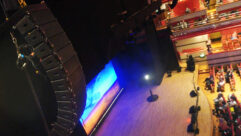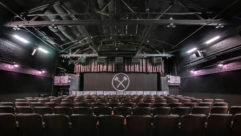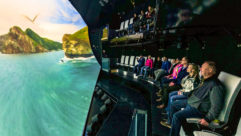
A Subtle Symphony Sound System
Mar 1, 2002 12:00 PM,
By Mel Lambert
The world-famous Benaroya Hall accommodates two performing halls ina complex that occupies an entire city block in downtown Seattle,Washington. Home of the Seattle Symphony Orchestra, the centerpiece ofBenaroya Hall is the S. Mark Taper Foundation Auditorium and thesurrounding Samuel and Althea Stroum Grand Lobby. The rectangular,2500-seat auditorium, built in 1998, offers a unique combination ofarchitectural and acoustical design that meld into a seamless aestheticexperience.
“Dark wood colors on the hall’s enclosing surfaces —with ivory tones on its inner layer of balcony fronts, coffered ceilingpanels and the stage enclosure — give the room a feel ofintimacy, visually and acoustically,” says hall director PatriciaIsacson Sabee. “Our seating arrangement was carefully studied toprovide excellent sight lines. And, in contrast to other rectangularconcert halls, box seating along the sidewalls is oriented toward thestage. Height of the proscenium is also emphasized, to achieve thedesired effect of intimacy with the audience.”
For symphony performances, the hall is magnificent. But, as theateroperations director Chris Miller explains, “There existed a needto provide announcements between musical sections — to allow theconductor to explain a section, for example — as well as amoderate-level P.A. system for light vocals that might accompany anorchestral performance.”
“Our major goal,” Isacson Sabee stresses, “was toprovide a [sound reinforcement] system that would be totallyunobtrusive and could be hidden from view during non-amplifiedconcerts. Any sound system we considered…had to blendaesthetically and emotionally with the hall’s fabric.”
FINDING AN ELEGANT SOLUTION
Under the guidance ofTheater Projects International, Benaroya Hall selected CCISystems, based in Olympia, to specify, design and install asuitable sound-reinforcement system to meet their exacting demands. CCIhas extensive experience working with large halls and spaces includingGund Arena in Cleveland, America West Arena in Phoenix, Safeco Field inSeattle, and many houses of worship around the world.

The auditorium’s main floor seats 1500 patrons, with the remaining1000 audience seats located in the tiers and boxes. “We decidedto fabricate a compact center cluster that could be mounted above theproscenium arch and provide primary coverage within theauditorium,” says Ronald Simonson, P.E., CCI’s principalconsultant and executive vice president. “Because some box-seatoccupants would be shadowed from the main cluster, we also decided toadd fill speakers mounted within the first- and second-tier boxes.Speakers were also designed into the area under the first tier to covermain-floor seating shadowed by the box seats above. In addition,ingenious stage-lip speakers are used to cover the first three rows ofthe main-floor seating area.”
The voice reinforcementsystem represented phase one of a 2-stage installation. Under thedirection of CCI Systems’ senior technician, Dave Bradley, the centercluster and distributed system were installed over a 12-week periodstarting in April 2001. Phase two, a performance sound system made upof flown left and right JBL Vertical Technology (VerTec) linearrays, is planned for late spring/early summer of this year, just intime for the summer season, which begins July 15. The larger-formatleft-center-right system will be used for concerts requiring a full-onsound reinforcement system; the eight JBL VerTec VT4889 three-way linearray cabinets suspended above each side of the stage area will beremoved during all other concerts.

CCI Systems worked closely with Harman Professional ProjectsGroup and the JBL Professional Custom Shop. JBL fabricated thecompact cluster components and stage-lip speakers. The total price ofBenaroya Hall’s first phase was about $400,000.
“For us, the project had three complementary aspects,”Simonson acknowledges. “First, the system had to offeroutstanding sonic performance with excellent medium-frequencydispersion into the auditorium. Second, it had to respect the acousticsenvironment of Benaroya Hall. And, third, it needed to respect thehall’s aesthetics. It was a unique challenge, and one that needed aparticular sensitivity.”
THE CENTER CLUSTER
Working closely with cci,Brad Ricks from Harman Professional Projects Group supervisedspecification and design of components for the center array, withtechnical assistance from JBL’s Custom Shop. “CCI was responsiblefor designing the mechanical assembly,” Ricks offers,“while HPPG designed the speaker elements and ensured that thesystem would cover the hall as evenly as possible and also fit into thesmall space we had available.”

To fullfill the design brief that called for a single speakercluster for voice and vocal performances, what was needed was an entiresystem that could fit into the compact 4×10-foot space above theproscenium (see Figure 1). The speaker cluster also had to beretractable, so it could be hidden away during orchestral concerts. (Amoving scrim mounted in front of the array ensures that the audienceremains unaware of the cluster’s presence.)
HPPG developed a specification that included separate HF and MFenclosures, plus angled HF horns. “Another consideration,”Simonson stresses, “was future compatibility with the [phase two]VerTec Series cabinets, so that the final system could be run as aleft-center-right configuration with full compatibility between allthree arrays.” As a result, CCI and HPPG selected JBL Model 2250mid-range drives, identical to those used in the VerTec VT4889three-way line array system. (Each VT 4889 enclosure includes two 225515-inch LF drivers, four 2250H 8-inch MF drivers and three 2435 HFdrivers on WaveFormers.)
In the center cluster, a pair of LF cabinets house two JBL Model2226 15-inch transducers in separate 46×15.6-inch cabinets.“That was quite a feat,” says Simonson. “Because oftight space restrictions, we had to make each cabinet as narrow as wecould. There was simply no extra room available in the aperture.”Each of the four 2226 drivers can handle 600 watts AES continuous pinknoise. They feature a 4-inch edge-wound aluminum ribbon voice coil inan SFG magnet structure using JBL’s vented gap cooling technology.
High frequencies are handled by a total of five assemblies aimed atsections of the audience. On each side of the array are mounted a pairof JBL Model 2352 medium-format, optimized-aperture bi-radial unitssplayed 45° off-axis, along with a pair of Model 2352s and anadditional 2352 horn aimed downwards. The 2300 Series comprises1.5-inch throat horns with different coverage patterns: Model 2352offers 90°×50° nominal dispersion. Each horn receives aModel 2451H-SL compression driver that incorporates a 4-inch puretitanium diaphragm with radial-rib topology and a 4-inch edge-woundaluminum voice coil. The design offers a quoted 100 watts of continuousprogram power handling when used above 500 Hz, and 150 watts above 1kHz.
Nine Model 2250J 8-inch midrange cone transducers are mounted withina separate MF cabinet measuring 23.5 inches wide by 40 inches tall. Thelower left corner has been truncated to accommodate the dispersionpattern of the HF horns. Capable of handling 350 watts, the 2250midrange cone driver features dual voice coils, neodymium magnet andlarge heat sinks.
“HPPG’s Brad Ricks designed the mid-frequency line array usingthe [Model 2250J] 8-inch drivers,” Simonson explains. “Bradcreated an MF line array design that worked fabulously in the hall. Heworked with me for the first couple of days during commissioning, and Iwas very impressed with this product. HPPG’s ability to develop customproducts like this for specific applications has really enhanced ourresources when we tackle unique and difficult projects.”
“The MF array works from 300 to 1100 Hz,” Ricks says.“It provides a single, vertically asymmetrical lobe of energyinto the room that evenly covers 90 percent of the audience areas towithin ±2 dB throughout its bandwidth. This coverage was crucialto the system’s success since, due to space constraints, we could notconsider using mid-frequency horns.”
According to Andrew Rutkin, director of custom project engineeringat JBL’s Custom Shop, “The project was [like] trying to squeeze aquart into a pint pot. With space being at such a premium —resulting in small cabinet sizes — heat buildup was a criticalconsideration. We needed to make sure that the boxes werewell-ventilated. It was fortunate that we needed to cut away the frontcorner of the MF cabinet to offer better HD coverage, since it alsoallowed for more cooling to internal components.”
The design team used physical spacing, aiming and extensive Soundwebdigital signal processing to ensure adequate vertical coverage from thecluster. The process, from specification to design and fabrication ofthe cluster at JBL’s Custom Shop, took around a month. “It was aone-shot deal, so we had to get it right the first time.”
PREPPING THE CUSTOM SPEAKERS
The entire center cluster needed to be able to extend some 42 inchesinto the auditorium, and be retractable during orchestral performances.“Per the client’s request, we designed and fabricated ahand-operated trolley system with flexible cabling that would notbecome snagged during movement of the speaker array,” Simonsonrecalls. CCI also needed to add extra security straps. “Workingwith the consulting structural engineer, SWMB of Seattle, we integratedsafety restraints so the system would be safe during earthquakes, andwe ensured that the cantilevered trolley could not fall forward intothe auditorium.”
Design of the extension trolley system was handled by CCI’s JohnGarrison. “We CAD-designed the rig in-house,” he offers,“and then had it fabricated out of house. We preassembled it herein our shop, took it apart and then reassembled it on-site. Theinstallation process in Seattle went very smoothly. We were able to rigthe system in just two days, using a crew of four.”
The central array is powered by a number of existing amplifierslocated in an adjacent equipment room, plus additional CrownMacro-Tech VZ Series MA5200 units. A number of BSS Soundweb 9008ii networked controllers han-dle signal distribution for the centralcluster, including DSP, delay and EQ.
Since the front section of the audience would fall outside of thecluster’s primary dispersion pattern, CCI decided to add supplementalspeakers mounted along the lip of the stage. “Since sight lineswere so critical, the JBL Custom Shop developed some amazing portablespeakers that are only 5 inches tall,” Simonson says. “Theeight JBL UCF 2531 units are powered by a Crown MA3600 amplifier, withall cabling recessed into the stage.”
“The lip speakers were designed to a tight size andperformance specification,” says Andrew Rutkin of JBL’s CustomShop. “For each cabinet, we specified dual 4-inch low-frequencydrivers, plus a pair of 1-inch dome tweeters stacked vertically. Weneeded to maintain vertical pattern control as much as possible andeliminate feedback by attenuating high frequencies.” Despite thecomponents it includes, the design features a small frontal area.“Squeezing 4-inch LF drivers into a box that only measures 4.5inches tall was some achievement!” Rutkin enthused.
DISTRIBUTED SOUND FOR THE BOXES
To provide adequate sound coverage to patrons in the first- andsecond-tier boxes, who would not have line-of-sight with the primarycentral cluster, CCI Systems developed a distributed system that wouldput more direct sound energy into these areas. Simonson explains,“We specified a total of 56 JBL Model HTI6 box speakers poweredby a bank of 6-channel Crown CP660 power amplifiers located in thelighting control room. A total of seven BSS Soundweb 9008ii signalprocessors/controllers, which provide individual delays, equalizationand signal processing for each loudspeaker/amplifier combination,control the entire system to ensure patrons hear sound that is in syncwith the onstage performance. Project electrical contractor, BurkeElectric, pulled speaker-wiring runs from each individual speakerback to the amplifier rack. Ron Long, Burke’s project manger, had theunenviable task of directing his crew in installing all of the systemwiring in a fully finished space where one mistake could damage rarefinishes that were critical to the hall’s acoustics.
“We spent a month determining how to best integrate thebox-seat speakers with the complex and critical architecture of thehall,” Simonson continues. Led by Benaroya’s project manager,Andrew Clapham, the team worked closely with Benaroya Hall’s acousticaldesigner, Dr. Cyril M. Harris, and project architect Jim Cade of LMNArchitects [Benaroya Hall’s designers]. The LMN design wasunobtrusive, acoustically correct and blended in directly with thehall’s architecture. According to Simonson, at one point BenaroyaHall’s board members were brought in to see if they could detect any ofthe 80 or so new speakers. They were pleased to report that they saw noevidence of them whatsoever.
STANDING OVATIONS
“The new vocal reinforcement sound system performs extremelywell,” Simonson states. “We wanted to provide high-qualitysound reinforcement coverage throughout the entire auditorium, and weaccomplished that. We spent three days aligning the central clusterwith the distributed speakers to ensure high intelligibility in each ofthe boxes.
“The result was a true team effort,” he continues,citing the talents of CCI Systems, Harman Professional Projects Groupand Benaroya Hall’s staff under project manager Andrew Clapham.“We received excellent feedback from the hall and gave them morethan we said we would. The team met weekly from three months before theproject started to two months afterward.”
The positive feelings are mutual. States theater operations directorChris Miller: “Working with CCI has been a very positiveexperience. We had one or two inevitable technical problems —including those hard-to-track electrical issues that always happen whenyou undertake a project of this complexity — but CCI workeddoggedly to eliminate them for us. They were absolutely concerned thatwe were happy with the results. In that regard, the project was a greatexperience.”
Isacson Sabee echoes Miller’s favorable opinion. “We are verypleased with the natural sound of the new system. And we like the factthat it is totally invisible to our patrons, yet capable of providingcoverage across the entire audience area.” She added thatBenaroya Hall’s acoustical designer Cyril Harris also agreed the systemwas a success, because of the quality of the installation and the wayit blends with the hall visually.
The system was unveiled in mid-September, with Danny Glover readingAbraham Lincoln’s speeches and letters during Aaron Copland’sLincoln Portrait. During the pre-Christmas season, the systemwas used for the Yuletide Pops Concerts to amplify the choir and leadsingers.
Since the unveiling, Benaroya Hall has hosted a number of keyperformances, including Ravi Shankar and his daughter, and the SeattleArts & Lecture Series with playwright Edward Albee and scientistStephen J. Gould. Future opportunities to show off the system includethe upcoming 44-week Seattle Symphony season, which will feature anumber of pop music performances, similar to those during theSymphony’s season last year with artists such as Natalie Cole and NinaSimone.
“All in all,” Chris Miller concludes, “the newsystem has exceeded our expectations.”
Mel Lambert founded Media & Marketing more than a dozen yearsago to provide communications and consulting services for pro audiofirms and facilities. More details are available atmel-lambert.com.
For More Information
BSS
bss.co.uk
Burke Electric
burkeelectric.com
Crown
crownaudio.com
Harman Professional Projects Group
harman.com
JBL
jblpro.com
Lowell
lowellmfg.com
Rapco
rapco.com










